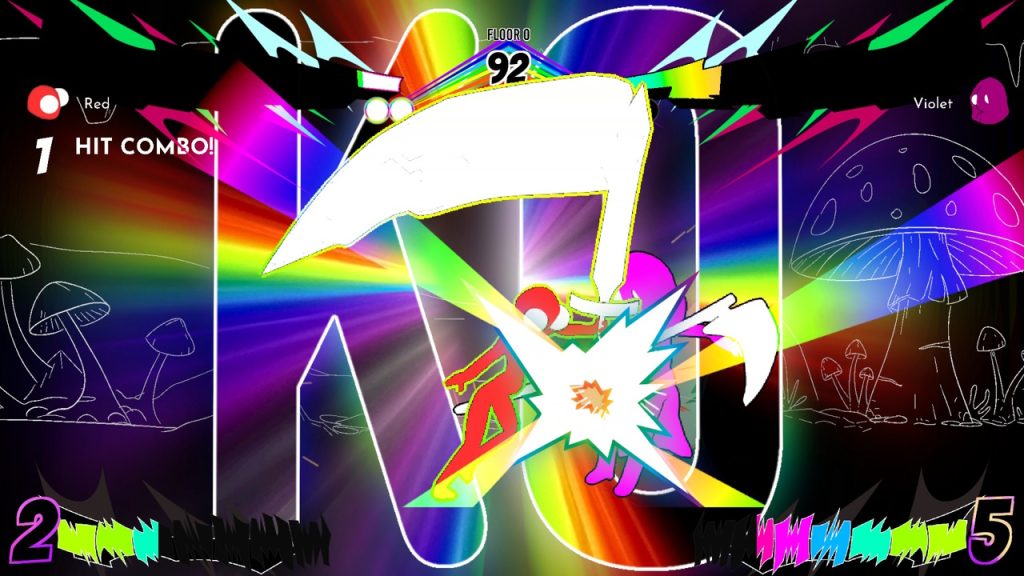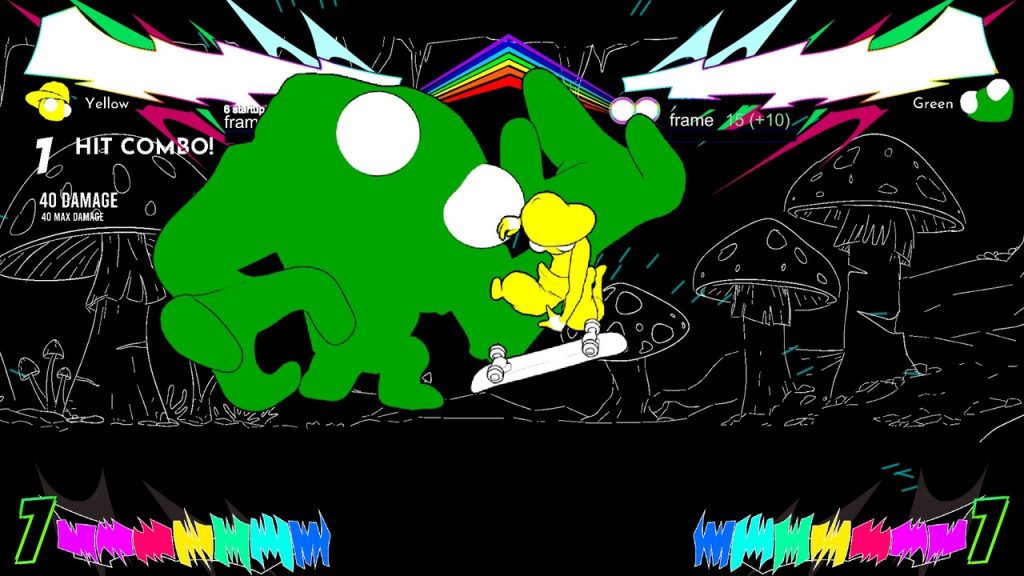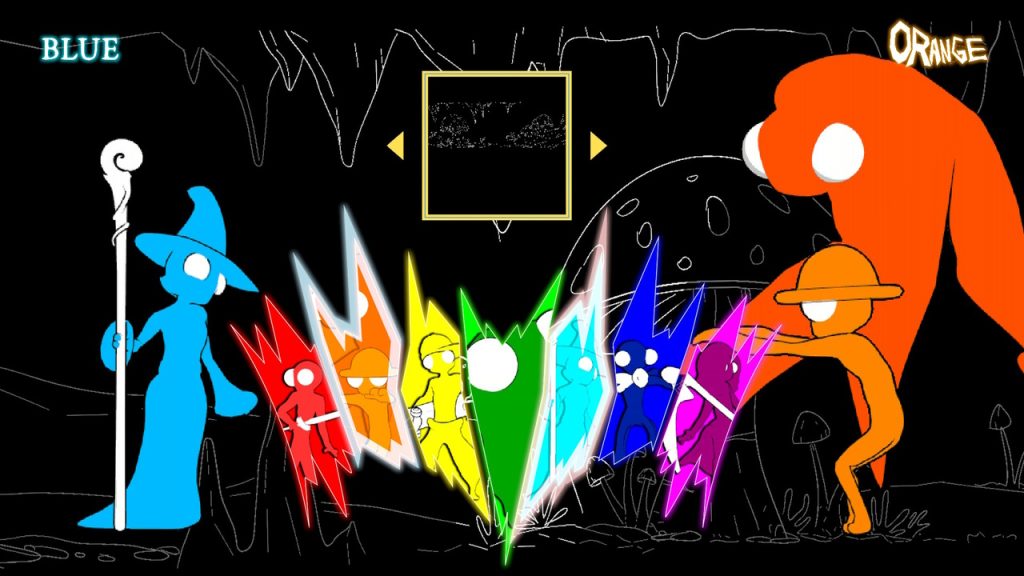This article is part of SuperCombo’s ongoing indie fighting game coverage. This time, we talk about Rainbowcore Hypernova, a free game with rollback netcode that stretches the boundary between traditional and platform fighters.

All the colors of the rainbow
Let’s face it: I have played so many fighting games that it has become exceedingly rare for me to be drawn in by just a screenshot or a short clip. Yet, somehow, Rainbowcore Hypernova had such a deliciously chaotic visual style that it was impossible not to notice it—with all the positives and negatives that this entails.
Since the moment I got wind of its near-release, thanks to indie streamer MrMKL, I’ve eagerly waited to put my hands on it and try it out, due to how “different” it looked, both in terms of visual and game mechanics.
So, after having gauged the game myself and upon review of tournament footage, I can confidently say that Rainbowcore Hypernova might be the most divisive indie fighting game I have played in a long time—which isn’t necessarily a bad thing, but grants some additional thoughts on the subject.
Simple and clean—on the surface
Rainbowcore Hypernova has a very defined art identity, with colorful silhouettes over black and white stages, which makes for a very legible action with a good contrast. In a way, its visuals reminded me of the colorful Head 2 Head, even if the similarity—if any—stops here, as the direction those games took couldn’t be more different.
The input system is extremely simple: You have two attack buttons, your direction and a dedicated dash macro. However, there is a complex interplay of mechanics on top of this, starting with traditional EX moves, going through supers that cost varying amount of meter, gliding on Guilty Gear’s Faultless Defense, and even landing on a sort of X-Factor/unlimited meter mode that consumes all your seven bars on a timer and also acts as a burst.
Despite the limited button budget (or, rather, because of it), the movesets of the characters make use of command normals and traditional fighting game motions, including quarter circles, dragon punches, half circles and charge motions—which, with the existence of a dash button, become even more nasty and aggressive (dash forward Sonic Boom anyone?).
At launch, there was no macro for pressing both attack buttons at the same time—but, fortunately this quality-of-life option has been already added as version 1.0. This comes rather handy, as this specific input is used for almost every advanced maneuver, including the absurdly far-moving metered directional influence.

Not gonna lie, you are going to see so many flashes, when playing this game. Unfortunately, this means photosensitive people might not be able to even try it out.
Directional WHAT, now?
Oh, yeah. So, this is where we go back to the beginning. I wrote that Rainbowcore Hypernova makes use of quite some mechanics from platform fighters. Well, the biggest departure from the traditional formula is the introduction of directional influence.
Directional Influence (or DI, for short), is a prominent game mechanic introduced in Super Smash Bros., which, quoting the incredible FGC glossary put together by Infilament, can be described as:
A mechanic in Super Smash Bros. (and many other platform fighters) that allows you subtly adjust which direction your character travels when they get hit. Often abbreviated as “DI”. After being hit (that is, on the very last frame of hitstop), the game will read the direction you’re holding the analog stick and adjust the angle you get launched. Specific details depend on the game in question; for maximum effect, sometimes you’ll want to influence your direction parallel to how the move naturally launches you, and other times you’ll want to hold the stick 90 degrees away from this angle. For example, to survive a strong vertical up-smash in Melee, you need to hold left or right — holding up or down will do nothing.
What this means in practice, is that DI makes launching combos not generally guaranteed, since the defender can always try to shift their momentum around. And, in a worst case, life-or-death scenario, they can also burn some meter to activate an enhanced version of it, thus providing an avenue to escape what looked like a dire situation.
The more you get hurt…
If that wasn’t enough to cause extreme variability in setups, offense and defense, Rainbowcore Hypernova ups the ante by making intelligent use of another staple mechanic from platform fighters—health-proportional knock-back: The lower the character’s health, the farther away they are flung when getting hit, but also the higher the hitstun they suffer. To make matters spicier, knock-back also scales with the amount of hits in a combo. This has the combined effect of making corner infinites impossible and adding yet another element of variability to the combo game: e.g. a sequence that could connect for every DI angles at full life may suddenly stop working as soon as the opponent has lost half or more of their health.
The way rounds are managed is also an interesting take on the genre: Instead of resetting the positions and health amount of the characters, Rainbowcore Hypernova uses an approach more similar to Killer Instinct and Injustice—that is, having the remaining health of the victor carry over to the next round. However, the catch is that the losing character will respawn at the center of the screen, with some brief moments of invincibility. During this intermission, the winner of the previous round is still free to move around and position themselves to play around it.

Aerial combos are fake, most times, as the opponent can use directional influence to escape them with relative ease—if your offense is predictable. Sidenote, but Yellow’s a capella theme is… a peculiar piece of art, to say the least. Skater dude likes to rap, apparently.
Stay on your toes
This interplay of relentless offense and strong defensive maneuvers results in a game of cat and mouse between the players, which makes Rainbowcore Hypernova much more difficult to “solve” in training mode. This is both a blessing and a curse:
- A blessing, because every exchange is tense and there is an immense sense of satisfaction in predicting your opponent’s DI angle and stuffing it with your highly damaging special move;
- A curse, because it makes it difficult to have just one or two reliable bread-and-butter combos, as the situation changes with both health amount and player habits. From this point of view, combo theory in Rainbowcore Hypernova is much nearer to—say—Super Smash Bros. Ultimate than to Street Fighter or Guilty Gear.
As a matter of fact, this game must be REALLY played against other humans to be fully appreciated and understood (yes, must), as labbing it in a vacuum or playing against the AI can only take a new player so far. The nuances of the defense mechanics and the sheer amount of influence the opponent can exert on your offense can be truly appreciated only in a real match.
Fortunately, the game has a pretty functional rollback netcode that eases the matchmaking experience—although it has been reported to suffer from hitches on lower-end machines.
Like the cover of a Pink Floyd album
Now, let’s talk about the roster! Rainbowcore Hypernova features seven playable characters, representing the colors of the rainbow and named accordingly.
- Red is the nearest thing to a shoto character, with a sort of setup projectile, an invincible reversal attack and an advancing, sword-spinning move.
- Orange is a puppet character, using a stand-like entity for setups and additional pressure;
- Yellow makes of mobility their biggest perk and is a pure, in-your-face, rushdown character;
- Green is the slow grappler without a dash that can dish out severe damage, but also be comboed heavily by most of the roster;
- Blue is a charge character with very good projectiles and setup tools;
- Indigo is the dedicated zoner of the bunch, shooting projectiles like there’s no tomorrow and taking advantage of some unique movement options;
- Violet is a sort of heavy hitting character with long range scythe pokes and good damage, but low mixup potential.
There is a decent variety in the roster, as no two characters play the same—but the game is far from having reached a significant balance, as the meta is still fresh and patches are gonna hit the shelves sooner rather than later.
Nevertheless, these blobs of colors are distinct enough just by means of their silhouettes, despite being little more than stickmen, that they can be recognized at a glance.
There’s currently no lore or story behind them, but each has an own character theme—a collection of a capella songs, performed with a very peculiar style, which might be more or less enjoyable depending on personal tastes.

The roster is as varied as it can get, with a character for each color of the rainbow. Sadly, there is currently only one stage to play on.
A very polarizing experience
Rainbowcore Hypernova is a game I cannot define as anything else but polarizing. The way it mingles traditional fighting game concepts with platform fighter conventions, the combo structure, the singular music choices, and the heavy usage of flashing visuals make it a game that is hard to recommend to everybody.
People with photosensitivity might want to avoid it like the plague, as it might strain their vision much like Ultra Fight Da! Kyanta 2 before the update that removed screen flashes. Players who are tepid towards the music choices might be tempted to mute the game or to replace the soundtrack altogether. Players who don’t like having to improvise combo routes or adapting to the opponent’s evasive maneuvers on the fly might also have a hard time with this game.
However, this isn’t necessarily something wrong or bad.
Rainbowcore Hypernova is bold, has good ideas and stands by its own design choices to the bitter end, which makes it one of the most interesting fighting games of 2023 and one of those with the strongest gameplay identity.
The basic movement is where this game needs some refinement: Walk speeds are abysmally slow, which means players have to commit to risky dashes, either aerial or grounded. High risk, high reward seems to be the driving principle behind this choice.
Don’t jump in expecting an easy-to-digest, cookie-cutter versus game, but keep an open mind: Rainbowcore Hypernova deserves a chance, whatever your opinion on fighters is, and I’m quite convinced it will manage to carve itself a unique niche, even in a panorama that is filled with more and more titles.
How to play it?
Rainbowcore Hypernova comes with a small amount of game modes and content, but considering it’s a free game one cannot hold this against it. It has a rather complete training mode, a local VS and VS CPU mode, a gauntlet-style arcade mode and online VS with rollback netcode. The game is available for free on Steam. You can follow the game’s Twitter profile for more information and updates or join the official Discord server for finding matches and sharing tech!
Before parting ways, here you are some tournament footage from the launch tournament! Notice that moves properties and combos might have changed compared to what’s shown here, after a couple balance patches!
Summary
Name: Rainbowcore Hypernova
Developer: Nucko Games (Twitter, Discord)
Available on: PC (Steam)
Price: Free
Year of release: 2023
Engine: Unity
Status: Released (version tested: 1.0, on 29 April 2023)
Netcode: Rollback netcode
In one sentence: A free-to-play colorful fighting game that skirts the line between a traditional and a platform fighter
Special thanks to MrMKL for bringing this game to my attention and to Yellowslotcar for acting as a consultant and reviewer for this article.
If you are interested in more coverage about indie fighting games, you can find me on Twitter at @AndreaDProjects
Other articles in the series
- Battle Craze!! — all good things come in threes
- Duels of Fortune – air-dashing action between simplicity and openness
- Indie Fighting Prototypes—Shuzen
- Footsies with cars – Buck Up and Drive
- Etehfowr Against – a charming, simultaneous 2v2 chaos
- Resistance 204X – a cyberpunk spiritual successor to Nidhogg
- Input Chaos – a twin stick ragdoll neon nightmare

